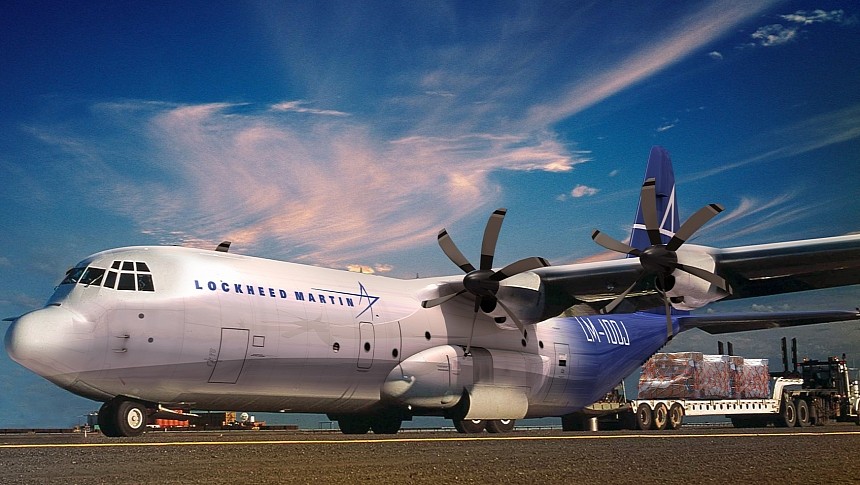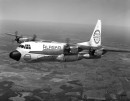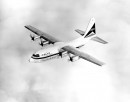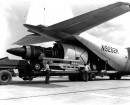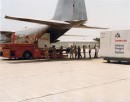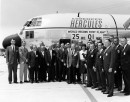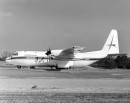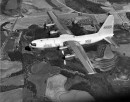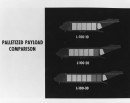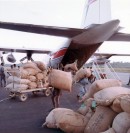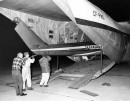The C-130 Hercules and its family can do just about anything, right? It can drop tens of thousands of pounds of cargo, equipment, vehicles, and soldiers over any battlefield, refuel multiple aircraft at a time, conduct photoreconnaissance, strafe ground targets with deadly autocannon fire, and even serve as an impromptu strategic bomber in a pinch depending on the variant But what if you're not trying to invade a hostile adversary? What if you're just a small, private cargo transport firm looking for the bar-none most reliable quad-engine, heavy-lift aircraft out there?
Well, it turns out Lockheed Martin's got you covered there too. This is the story of the Lockheed L-100 Hercules, the timeless classic C-130 Hercules taken out of its military garb and made to wear a fine-pressed civilian suit. Safe to say, the L-100 is still all business underneath despite the slight change in appearance. To understand why Lockheed even bothered turning their prized military transport plane into a cargo liner for civilians, we need to go back to the late 1950s. By 1959, the original Lockheed C-130A Hercules had already been in service with the U.S. Air Force for three years.
On its introduction into service, the C-130 was nothing short of a transformative airplane. In an age when most cargo haulers were still running sluggish, leaky piston engines with greatly limited performance, the Hercules might as well have been an alien spacecraft compared to the competition. But little do people remember these days, but this wasn't all that Lockheed had planned for the Hercules platform at the time. On the drawing board at the time planned for two upgrade paths for the C-130 using the same basic airframe but sprinkled with extra helpings of "special sauce."
Dubbed the GL-207 Super Hercules, plans called for an airframe roughly 23.4 feet (7.11 meters) longer than the standard C-130A and powered by upgraded variants of the Hercules' Allison T56 turboprop engines cranking out 6,000 shaft hp each. There was even a turbofan-powered variant considered, set to be powered by the same Pratt & Whitney JT3D engines famous for their use in the Boeing 707 airliner and the B-52H Stratofortress strategic bomber. By 1959, Lockheed had secured order contracts from Pan American World Airways (Pan Am) and a long-forgotten Texas-based airline called Slick Airways.
For reasons that aren't quite clear, both Slick and Pan Am opted to cancel their orders for the GL-207 by the turn of the 1960s. Almost as if like a consolation prize for itself, Lockheed began work designing a more conventional civilianized variant of the standard C-130E Hercules which it could market to private-sector airlines in need of something reliable to haul both cargo and people. Dubbed the L-100, the new cargo plane was built with the same military-grade precision which benefitted the C-130 to great effect.
With dimensions of 112 feet, nine inches (34.35 m) long and a 132-foot, seven-inch (40.4-m) wingspan, the L-100's civilian variants of the T56 engines, the 501-D22A can lift upwards of 50,000 lbs (22,679.6 kg) of cargo to an altitude of 23,000 feet (7,000 m) and a cruising speed of 336 mph (292 kn, 570 kph). Perfectly suitable for the kind of short-distance but high-capacity civilian cargo hauling that Lockheed intended the L-100 to service. As if to prove a point on its first time out, the first prototype L-100 to fly completed a 25-hour, non-stop marathon flight without refueling on its very first test flight on September 30th, 1965.
After receiving its FAA certification in February of the same year, Lockheed commenced production on the first 21 examples of the L-100, with the first being delivered to Continental Air Services. But if Lockheed expected the L-100 to light up the civilian space as the C-130 did for global militaries, they were soon to be greatly disappointed. Though the plane ostensibly performed as advertised, Lockheed had a great deal of trouble finding suitable customers to sell their aircraft to in light of an oversaturated and well-catered-to civilian cargo sector rife with 707s, DC-8s, and all manner of other, more readily available aircraft.
To try and garner more sales, Lockheed designed two further modifications to the L-100's airframe to try and improve its cargo capacity and reliability, dubbed the L-100-20 and L-100-30. Unfortunately, changes in global civilian cargo liner operations to favor larger turbofan aircraft over medium-sized turboprop planes meant Lockheed's target audience generally found itself interested in airplanes other than the L-100. Between 1964 and 1992, only 114 L-100 airframes were delivered, mostly to small-regional airlines and, ironically, foreign air forces like Mexico, El Salvador, Libya, Peru, and the Philippines.
In most instances, a failure of this degree would've spelled the end of the L-100's story once its production wrapped up in 1992. But while the civilianized C-130 languished in near-irrelevancy, its militarized cousins continued a steadfast and relentless development cycle. An upgraded variant of the L-100 based on the C-130J Super Hercules had been in development since the late 1990s but was unceremoniously shelved in the year 2000. With the attacks of September 11th, 2001, happening just a year later, the newly-merged Lockheed Martin would take a full 15 years to unveil the L-100's successor, the LM-100J, in April 2016.
With entirely overhauled avionics and upgraded engines courtesy of Rolls-Royce, it all leads to improved cargo capacity and in-flight performance. Lockheed Martin expects the L-100J to supplement existing fleets of standard L-100s rather than act as a competitor for other cargo liners, which it sees as a more realistic achievable goal than competing outright with other jets. Besides, the L-100J can fly to places other cargo liners wouldn't dare attempt. Though not a guarantee of success, Lockheed Martin anticipates selling at least 75 L-100J airframes, all manufactured at Lockheed Martin's production facility in Marietta, Georgia.
At the very least, the L-100J's Dowty R391 scimitar-shaped propellers let you know right away it's not another USAF surplus jalopy that's been sitting mothballed in the desert for heaven knows how long. The rear-fuselage doors, which don't open at the back like a paratrooper drop-ship, are another big indicator of the special kind of bird the L-100J truly is. The L-100J's Enhanced Cargo Handling System (ECHS), also found on the C-130J, is bound to make life infinitely easier for civilian crews as it does militarized ones. One word of warning, however. The C-130J's had its in-flight flush toilet deleted as a means of saving weight. Meaning, you better darn well use the lavatory before this leviathan takes to the skies, or you're definitely in for an agonizing ride.
Hey, when every kilo counts the way it does in the cargo-transport biz, you're willing to make such omissions. But then again, in-flight microwave ovens, coffee makers, and integrated refrigeration units are optional extras for the L-100J Super Hercules. Just in case any of the flight crew happens to be a java junkie with the sudden urge to munch on a Hot Pocket in the middle of a short-haul puddle jumper flight full of expensive, outsized cargo. Though not the most interesting or exciting variant of the C-130 ever built, there's something infinitely interesting about a military cargo plane made to serve the civilian market with such minimal changes to its airframe.
As the C-130 platform enters its eighth calendar decade in operation, it'd simply be wrong to omit the L-100 from the history books. For this reason, we wanted to give it just a little bit of a spotlight. But what do you folks think? Is Lockheed Martin right to even bother with such a niche and specialized civilian aircraft when there are seemingly endless C-130J orders left to fill? Or is there always a spot in the aviation-geek space for quirky, interesting aircraft with a fascinating story to tell? Let us know your thoughts in the comments down below.
On its introduction into service, the C-130 was nothing short of a transformative airplane. In an age when most cargo haulers were still running sluggish, leaky piston engines with greatly limited performance, the Hercules might as well have been an alien spacecraft compared to the competition. But little do people remember these days, but this wasn't all that Lockheed had planned for the Hercules platform at the time. On the drawing board at the time planned for two upgrade paths for the C-130 using the same basic airframe but sprinkled with extra helpings of "special sauce."
Dubbed the GL-207 Super Hercules, plans called for an airframe roughly 23.4 feet (7.11 meters) longer than the standard C-130A and powered by upgraded variants of the Hercules' Allison T56 turboprop engines cranking out 6,000 shaft hp each. There was even a turbofan-powered variant considered, set to be powered by the same Pratt & Whitney JT3D engines famous for their use in the Boeing 707 airliner and the B-52H Stratofortress strategic bomber. By 1959, Lockheed had secured order contracts from Pan American World Airways (Pan Am) and a long-forgotten Texas-based airline called Slick Airways.
For reasons that aren't quite clear, both Slick and Pan Am opted to cancel their orders for the GL-207 by the turn of the 1960s. Almost as if like a consolation prize for itself, Lockheed began work designing a more conventional civilianized variant of the standard C-130E Hercules which it could market to private-sector airlines in need of something reliable to haul both cargo and people. Dubbed the L-100, the new cargo plane was built with the same military-grade precision which benefitted the C-130 to great effect.
After receiving its FAA certification in February of the same year, Lockheed commenced production on the first 21 examples of the L-100, with the first being delivered to Continental Air Services. But if Lockheed expected the L-100 to light up the civilian space as the C-130 did for global militaries, they were soon to be greatly disappointed. Though the plane ostensibly performed as advertised, Lockheed had a great deal of trouble finding suitable customers to sell their aircraft to in light of an oversaturated and well-catered-to civilian cargo sector rife with 707s, DC-8s, and all manner of other, more readily available aircraft.
To try and garner more sales, Lockheed designed two further modifications to the L-100's airframe to try and improve its cargo capacity and reliability, dubbed the L-100-20 and L-100-30. Unfortunately, changes in global civilian cargo liner operations to favor larger turbofan aircraft over medium-sized turboprop planes meant Lockheed's target audience generally found itself interested in airplanes other than the L-100. Between 1964 and 1992, only 114 L-100 airframes were delivered, mostly to small-regional airlines and, ironically, foreign air forces like Mexico, El Salvador, Libya, Peru, and the Philippines.
In most instances, a failure of this degree would've spelled the end of the L-100's story once its production wrapped up in 1992. But while the civilianized C-130 languished in near-irrelevancy, its militarized cousins continued a steadfast and relentless development cycle. An upgraded variant of the L-100 based on the C-130J Super Hercules had been in development since the late 1990s but was unceremoniously shelved in the year 2000. With the attacks of September 11th, 2001, happening just a year later, the newly-merged Lockheed Martin would take a full 15 years to unveil the L-100's successor, the LM-100J, in April 2016.
At the very least, the L-100J's Dowty R391 scimitar-shaped propellers let you know right away it's not another USAF surplus jalopy that's been sitting mothballed in the desert for heaven knows how long. The rear-fuselage doors, which don't open at the back like a paratrooper drop-ship, are another big indicator of the special kind of bird the L-100J truly is. The L-100J's Enhanced Cargo Handling System (ECHS), also found on the C-130J, is bound to make life infinitely easier for civilian crews as it does militarized ones. One word of warning, however. The C-130J's had its in-flight flush toilet deleted as a means of saving weight. Meaning, you better darn well use the lavatory before this leviathan takes to the skies, or you're definitely in for an agonizing ride.
Hey, when every kilo counts the way it does in the cargo-transport biz, you're willing to make such omissions. But then again, in-flight microwave ovens, coffee makers, and integrated refrigeration units are optional extras for the L-100J Super Hercules. Just in case any of the flight crew happens to be a java junkie with the sudden urge to munch on a Hot Pocket in the middle of a short-haul puddle jumper flight full of expensive, outsized cargo. Though not the most interesting or exciting variant of the C-130 ever built, there's something infinitely interesting about a military cargo plane made to serve the civilian market with such minimal changes to its airframe.
As the C-130 platform enters its eighth calendar decade in operation, it'd simply be wrong to omit the L-100 from the history books. For this reason, we wanted to give it just a little bit of a spotlight. But what do you folks think? Is Lockheed Martin right to even bother with such a niche and specialized civilian aircraft when there are seemingly endless C-130J orders left to fill? Or is there always a spot in the aviation-geek space for quirky, interesting aircraft with a fascinating story to tell? Let us know your thoughts in the comments down below.
